Guest feature | The second screen phenomenon – hidden treasure waiting to be discovered?
The world is in a state of rapid change. We have new technologies, devices that keep getting smaller and smarter, and digitalization with its seemingly boundless reach – all making inroads into everyday lives, which as people are noticing are also in a state of transformation. New mobility and workplace models are also changing our routines. And these changes are also impacting on the way millions of people watch television. While video on demand services like Netflix and Amazon Video grow in popularity and gain more and more market share – thanks in part to their premium original programming – Google subsidiary YouTube has also shown its potential as a television substitute, especially for the younger generation. So who’s still watching TV?

It’s true that in recent years, there has been a measurable decrease in the number of linear television viewers. In educated circles, saying “I don’t watch TV anymore” is a badge of pride, proof of one’s hipness. Despite fun late-night programming and interesting talk shows and documentaries, television seems to have lost its edge among young people.
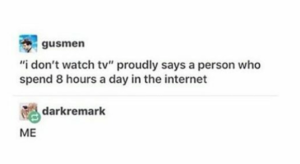
Source: Tumblr
In the United Kingdom alone, there was a 22.5% decrease in viewer numbers between 2010 and 2013. But we shouldn’t forget how widespread television actually is.
People who still watch linear TV are frequent and loyal viewers
Traditional television cannot keep up with the desire of digital natives for instant gratification. But TV does have a group of loyal and frequent viewers – such as the people who like to tune out their daily stress by enjoying shows like the German soap opera Gute Zeiten, schlechte Zeiten or its American cousin All My Children. Or those who just sometimes switch on the TV to see what’s on. Or people whose appointment viewing of “their” show provides a point of reference in their busy lives. Plus there are viewers who love TV for its reliable routine – favorite soap at 4 p.m., consumer report at 6 p.m., news at 8 p.m. Every day, Monday to Friday. No searching, no annoying downloads, no making sure the Wi-Fi is working. Just switch on the TV, tune out the world, and relax.
Despite all this, a move toward video on demand can still be seen among this group of viewers. And what’s causing it? When we turn on our televisions nowadays, we’re bombarded with commercials. Traditional TV advertising doesn’t hold a candle to modern online marketing – it’s expensive, it can’t be disguised in the form of content marketing, and it’s very difficult to measure its effectiveness. But it’s there. So what do we do nowadays when our shows get interrupted? We reach for our smartphones – and quickly lose ourselves in the world of the second screen.
The use of smartphones or tablets while watching television is not just picking up during commercial breaks, but also during the show itself. Viewers text their friends on WhatsApp, google information about the show – actors, filming locations, soundtrack – or, in the most classic case, send tweets about what they’ve just seen. According to a 2015 study by adweek.com, a whopping 87% of all consumers use more than one device while watching TV. In the case of millennials, there is a clear preference for smartphones: 74% of 14- to 17-year olds use their mobiles as a second screen when watching TV.
The potential of the second screen is clear – the question is how to leverage it
We tend to steer clear of things that are difficult to use and to completely ignore ones where we don’t see the benefit. A certain hurdle has to be cleared before we’ll even go to the trouble of hitting the download button. So the benefits of a second screen app have to be obvious enough to overcome user inertia.
Currently the app most frequently used while watching TV is Twitter, which is not a second screen app per se. And Twitter itself is still in the red, while the only benefit to the television broadcasters is the coincidental buzz that is generated about their show – whether positive or negative.
Examples of established second screen apps in Germany
In Germany, the direct consumption of television content on mobile devices is made possible through the applications offered by major broadcasting companies such as RTL and ProSiebenSat.1, who are trying to cash in on subscription models. RTLnow and RTLive are well-known examples of such apps. Even though they have been on the market for many years, they still don’t offer their users supplementary information or dynamic content.
The TVMovie app demonstrates users’ preference for simplicity. In Germany alone, this digital version of the television programming guide has some 100,000 users. The free app not only offers an up-to-date program schedule, but also an option for setting up your own channel list – plus a “bathroom timer” that signals the end of the commercial break!
Here is a small sample of the best-known TV programs in Germany and the average number of tweets they received per episode:
- Tatort (ARD crime drama): 6,000-9,000 tweets
- Germany’s Next Topmodel (Pro7): around 8,000
- Circus Halligalli (Pro7): around 9,000
- Hart aber fair (ARD politics): 2,000-4,000
- Eurovision Song Contest (multiple channels): at least 30,000 (tweets in German)
(Source:FlickStuff Analytics)
30,000 tweets for one show is not a lot compared to the total number of viewers. But Twitter is also a passive medium – there are significantly more users reading tweets than writing them. Social TV apps like TunedIn and Zapitano attracted investors but didn’t enjoy lasting market success. Both apps let users interact with other viewers, while TunedIn supplemented the social aspect by providing additional information about the show. But there doesn’t seem to have been enough added value to make them attractive to viewers.
Second screen startups in Europe
Germany
To date, apps that have been launched have focused on the following aspects:
- Social interaction – The viewer is able to swap opinions with other fans of a program.
- Additional information on the program – As viewers want to know more and more about their shows, this feature saves them from having to google for information themselves.
- Making advertising more attractive – The viewer is able to collect points by watching commercials/correctly answering questions and then exchanging them for things of actual monetary value like discount coupons or prizes.
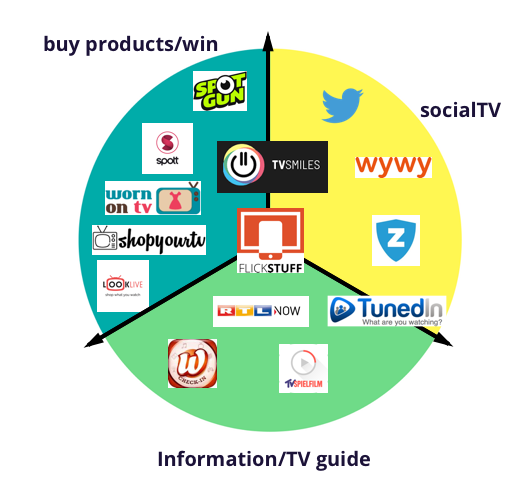
Source: Author
In Germany, the TVSmiles app, which markets itself as a bonus program for television, has been well received by viewers. By answering questions related to ads and other quiz questions, users are awarded “smiles” that they can trade in for prizes or vouchers to use on Amazon. The customer benefits of this app are open to dispute, and individual viewers will have to judge for themselves whether using the app is really worth it, but the user numbers speak for a positive experience.
TVSmiles is now part of the Pro7Sat1 family and, according to its own figures, now has 450,000 registered users who spend an average of 90 minutes per month playing on the app and who have so far claimed more than 20,000 prizes.
Second screens in international comparison
The Netherlands: https://spott.it/en/
The Dutch startup spot.it “allows you to find products in the things you watch.” This means that information is provided on products that appear in a TV show – like the dress worn by the weathergirl, as seen in the following screen shot from the website:
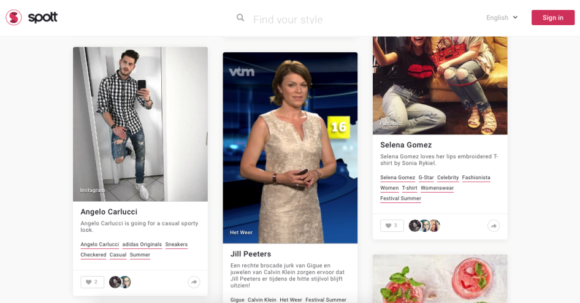
Source: spot.it
Similar models can also be found in the United States:
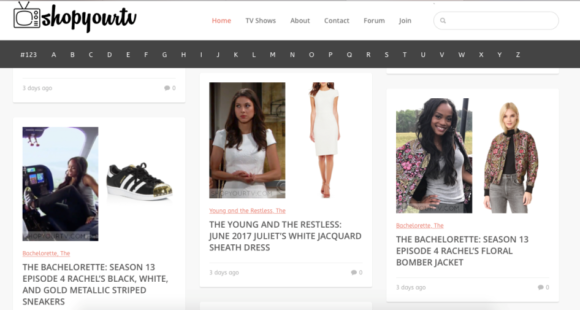
Source: shopyourtv.com
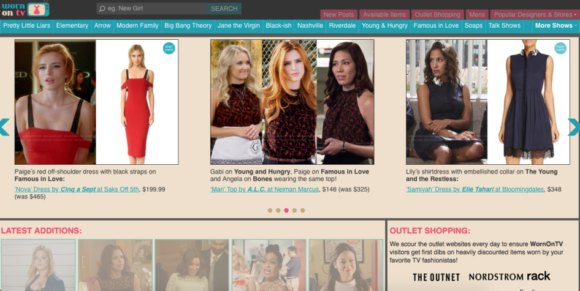
Source: wornontv.com
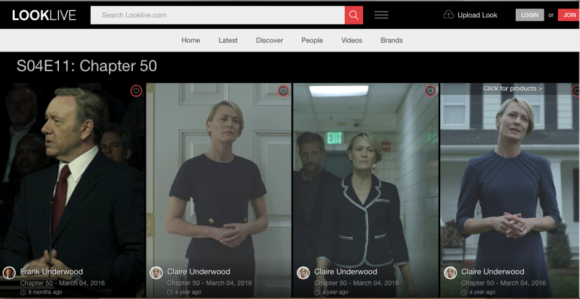
Source: looklive.com
The fashion articles that are shown do not appear simultaneously during the broadcast; you have to look for them after the show. But the demand has been identified – by the broadcasters as well, as reported by outlets such as Digiday UK.
In the United States, where there is said to be a television in almost every room, there is a correspondingly large range of established second screen apps. Apps like The Nick App and HBOgo focus on providing supplementary information on the show as well as videos, similar to the RTL app mentioned above.
The second screen: hype – or the future of TV?
The move toward second screen usage is a measurable trend.Now the challenge is developing effective business models.
Saving the best for last
OR Why I’m wasting my youth writing 11,406 characters on the topic of second screens
Some three years ago, my colleague Domi was watching a TV show and saw a couch that he just had to have. He combed the internet, but couldn’t find that couch. As a budding computer engineer, he wasn’t going to give up so easily. He kept looking for an application, a program, or a page that could answer his question for him. Frustrated by the fact that such a thing still didn’t exist in 2014, he decided to tackle the problem in collaboration with fellow student Johannes and professor Dr. Schmidt. Domi and Johannes focused their master’s theses on the topic of second screens, developing complicated algorithms. And the result was the FlickStuff app!
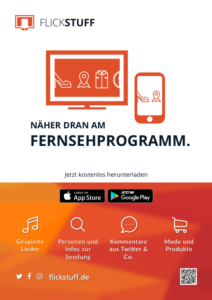
Source: FlickStuff
The free FlickStuff app is designed to offer viewers a comprehensive live stream for all television shows. It currently works for the 30 most popular freeview TV channels in Germany plus RegioTV Schwaben, and its creators are planning to expand to on-demand programming. Despite the growing reach of new services, television is still the number one media in Germany, which is why that’s where they’re focusing first. “In principle, however, our processes are adaptable to Netflix, YouTube, Amazon Video, and other on-demand formats,” explains Johannes, the FlickStuff team member responsible for the backend.
In FlickStuff, information appears simultaneously with the TV show
The app delivers real-time background information, the titles of songs that are played, products that appear, and tweets about the TV show. This is possible because the provision of information has been automated. The app lets you select which information should primarily be visible. This makes sure that viewers aren’t subjected to information overkill.
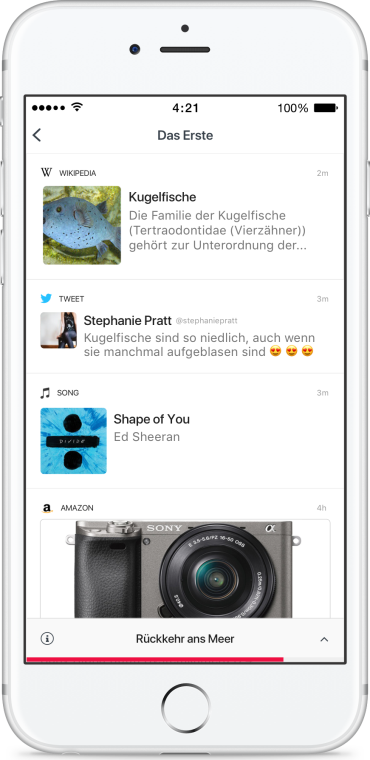
Source: FlickStuff
Right now our friends all use the app differently. Political science students have FlickStuff explain terms during political talk shows, while soap fans use it to get song titles. Unlike Shazam, in FlickStuff you can scroll back in the show and it also isn’t a problem if the song only plays for a few seconds or if the characters are talking over it. The app really recognizes every song – in the program or in the commercials.
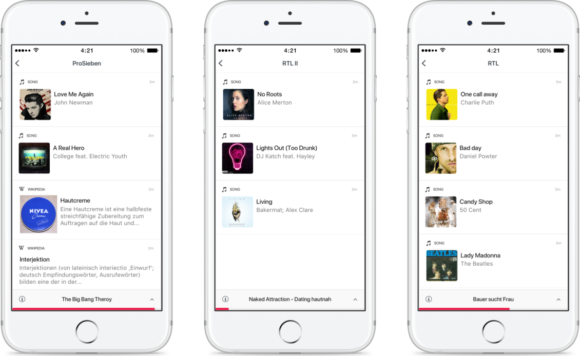
Source: FlickStuff
Here’s an example from the episode of the popular German police procedural Tatort that aired on June 5, 2017: The book Le Fleur mal was mentioned as part of the story. In about three milliseconds, the FlickStuff algorithm had automatically called up both the German and the original French edition on Amazon. And the same principle is used for song titles. So it can be used for classic affiliate marketing.
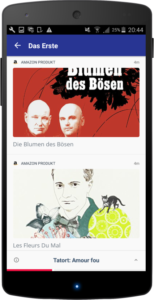
Source: FlickStuff
And if you spin out the concept a bit further, a wide variety of business models are possible. For example, the broadcasters could place significantly more products in their programs, creating an additional source of income that is more precisely scalable than traditional blocks of advertising – because the effectiveness can actually be measured by the looking at the sales figures. The advantage for the viewer is clear: annoying commercials could be eliminated if more advertising was hidden in the program itself. And since the dawn of YouTube, that doesn’t really bother anyone anymore.
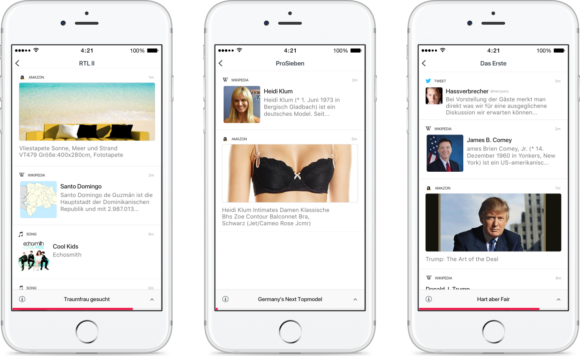
Source: FlickStuff
“The software shall be used for good, not evil” – Excerpt from the FlickStuff T&Cs
Our persistence has paid off, the first broadcaster is excited about our idea, and we launched a partnership with RegioTV Schwaben in mid-June. The project is the perfect way to get to know TV viewers. If the app takes off, it will mean a new business model for the broadcaster and its advertisers – and for us, confirmation that we aren’t the only ones who think our app is cool!
At present, the following commercial is being featured (in German):
According to our business plan, the FlickStuff app hits scalability criteria at 100,000 users. Every day, some 80,000 new apps are launched, so our undertaking is just as ambitious as it seems. But after all, if it wasn’t a challenge, it would be boring! Risk – woo-hoo! We’ll take our chances – let’s see if people try out the app, and if they do, whether they like it, and then we’ll go from there. I’m feeling optimistic. After all, the sun is shining and life is good! 🙂






Write a comment